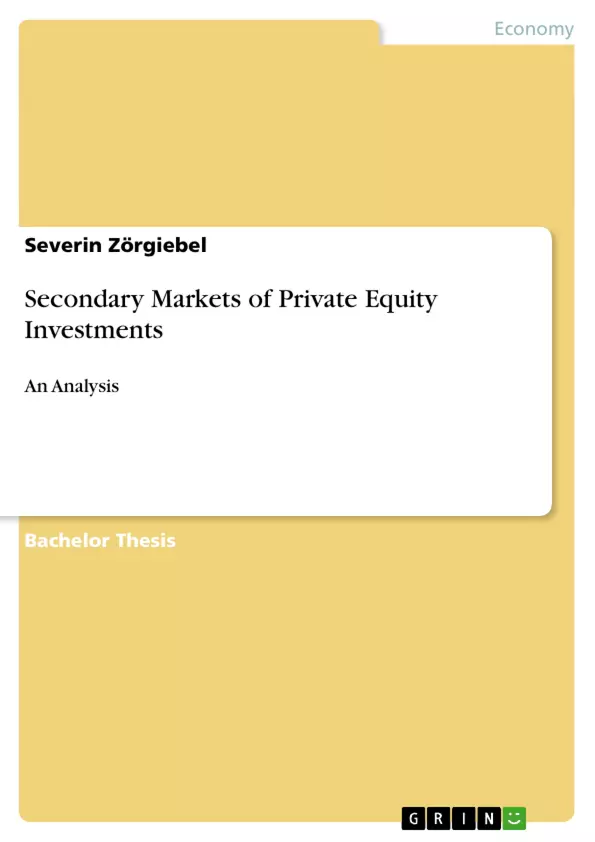Private equity is an asset class with one notorious problem: illiquidity. First,investments are made without an exit option prior the determined maturity and second it is nearly impossible to purchase an interest of an existing private equityfund.
For the last few years these issues have been changing due to the development and the emergence of a secondary market in the field of private equity (PE) which opens new investment opportunities and “provides investors with liquidity in an extremely illiquid asset class.” The main market indicators are growth and maturity. Especially in the financial sector of secondary markets the development of these indicators should be named. The PE secondary market is in a very early state and far from institutionalized markets like stock exchanges.
Heavy market imperfections are a problematic characteristic in this context. Buyers and sellers have to meet privately and negotiate an agreement. Holding an asset for such a long period like in PE can be very unnatural and difficult in a fast moving world in which the need for liquidity and changing regulations, economic situations or other issues emerge very quickly. In consequence, an efficient secondary market seems to be important and necessary to face these problems and give investors the ability to participate and unload assets when circumstances force them to do so.
The PE secondary market is a relatively new phenomenon and is characterized by steady movement, change and development. Experts from market leading secondary funds and advisory services attest the PE secondary market an essential progress. The PE secondary market transforms from a market for unloading poor performing assets, to an instrument for providing chances in the way of an active portfolio management tool. This Bachelor Thesis, titled “Secondary Markets of Private Equity Investments – An Analysis” has the main target to give a prevailing and critical overview of this subject.
Inhaltsverzeichnis (Table of Contents)
- 1. Introduction
- 2. Definitions
- 2.1. Venture Capital vs. Private Equity
- 2.2. Primary market
- 2.3. Secondary market
- 3. History of Private Equity secondary markets
- 4. Characteristics of Private Equity secondary markets
- 4.1. Financing stages of Private Equity
- 4.2. Participants
- 4.2.1. Sellers
- 4.2.2. Buyers
- 4.2.3. Intermediaries
- 4.3. Reasons for attendance
- 4.3.1. Liquidity
- 4.3.2. Returns
- 4.3.3. Diversification and active asset management
- 4.3.4. Fund access
- 4.3.5. Other reasons
- 4.4. Influence on the primary market of Private Equity
- 4.5. Market imperfections
- 5. Secondary transactions
- 5.1. Process of secondary transactions
- 5.2. Types of secondary transactions
- 6. Cogent Secondary Market Model
- 6.1. Background of the model
- 6.2. Procedure
- 6.3. The model
- 6.4. Predictions of the model
- 7. New markets and investment opportunities
- 7.1. Securitization
- 7.1.1. Overview
- 7.1.2. Process of a Private Equity securitization
- 7.1.3. Motivations and outlook
- 7.2. IPOs of Private Equity funds
- 7.3. Online Exchanges
- 8. Conclusion and outlook
Zielsetzung und Themenschwerpunkte (Objectives and Key Themes)
This analysis of secondary markets of private equity investments aims to explore the dynamics of this burgeoning market. The work delves into the historical development, key characteristics, and various types of secondary transactions. The focus is on understanding the motivations behind participation in secondary markets, their impact on the primary market, and the identification of emerging opportunities.- Characteristics of Private Equity secondary markets
- Motivations for participation in secondary markets
- Impact of secondary markets on the primary market
- Types and processes of secondary transactions
- Emerging opportunities in private equity secondary markets
Zusammenfassung der Kapitel (Chapter Summaries)
- Chapter 1 introduces the topic of private equity secondary markets and sets the stage for the subsequent analysis.
- Chapter 2 provides essential definitions related to venture capital, private equity, and the distinction between primary and secondary markets.
- Chapter 3 outlines the historical development of private equity secondary markets, tracing their evolution from early beginnings to their current state.
- Chapter 4 explores the key characteristics of private equity secondary markets, focusing on financing stages, participants, reasons for attendance, and market imperfections.
- Chapter 5 examines the process and various types of secondary transactions, highlighting different approaches to investment opportunities in the secondary market.
- Chapter 6 delves into the Cogent Secondary Market Model, analyzing its background, procedure, and predictions regarding future market trends.
- Chapter 7 discusses emerging markets and investment opportunities within private equity secondary markets, focusing on securitization, IPOs of private equity funds, and online exchanges.
Schlüsselwörter (Keywords)
This research focuses on private equity secondary markets, examining key characteristics, motivations for participation, and the impact on the primary market. It explores various types of secondary transactions, emerging markets, and investment opportunities. Central concepts include liquidity, returns, diversification, fund access, and market imperfections.- Quote paper
- Severin Zörgiebel (Author), 2008, Secondary Markets of Private Equity Investments, Munich, GRIN Verlag, https://www.grin.com/document/131222



